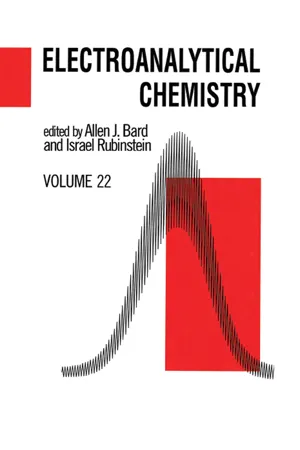
eBook - ePub
Electroanalytical Chemistry
A Series of Advances: Volume 22
This is a test
- 312 pages
- English
- ePUB (mobile friendly)
- Available on iOS & Android
eBook - ePub
Book details
Book preview
Table of contents
Citations
About This Book
For more than three decades the Electroanalytical Chemistry series has delivered the most in-depth and critical research related to issues in electrochemistry. Volume 22 continues this gold-standard with practical reviews of recent applications, as well as innovative contributions from internationally respected specialists highlighti
Frequently asked questions
At the moment all of our mobile-responsive ePub books are available to download via the app. Most of our PDFs are also available to download and we're working on making the final remaining ones downloadable now. Learn more here.
Both plans give you full access to the library and all of Perlego’s features. The only differences are the price and subscription period: With the annual plan you’ll save around 30% compared to 12 months on the monthly plan.
We are an online textbook subscription service, where you can get access to an entire online library for less than the price of a single book per month. With over 1 million books across 1000+ topics, we’ve got you covered! Learn more here.
Look out for the read-aloud symbol on your next book to see if you can listen to it. The read-aloud tool reads text aloud for you, highlighting the text as it is being read. You can pause it, speed it up and slow it down. Learn more here.
Yes, you can access Electroanalytical Chemistry by Allen J. Bard,Israel Rubinstein in PDF and/or ePUB format, as well as other popular books in Education & Education General. We have over one million books available in our catalogue for you to explore.
Information
THE INDIRECT LASER-INDUCED TEMPERATURE-JUMP METHOD FOR CHARACTERIZING FAST INTERFACIAL ELECTRON TRANSFER: CONCEPT, APPLICATION, AND RESULTS
Stephen W. Feldberg, Marshall D. Newton, and John F. Smalley
Brookhaven National Laboratory, Upton, New York, U.S.A.
I. | INTRODUCTION
| ||||||||||||||
II. | THE EVOLUTION OF THE ILIT METHOD FOR THE STUDY OF FAST INTERFACIAL ELECTRON TRANSFER KINETICS
| ||||||||||||||
III. | RELEVANT ELECTRON TRANSFER THEORY: MARCUS’S DESCRIPTION OF HETEROGENEOUS NONADIABATIC ELECTRON TRANSFER REACTIONS
| ||||||||||||||
IV. | ANALYSIS OF THE ILIT RESPONSE
| ||||||||||||||
V. | EXPERIMENTAL IMPLEMENTATION OF ILIT
| ||||||||||||||
VI. | A FEW EXAMPLES OF MEASUREMENTS OF INTERFACIAL KINETICS
| ||||||||||||||
VII. | THE POTENTIAL OF THE ILIT APPROACH | ||||||||||||||
VIII. | SOME THOUGHTS ABOUT FUTURE EXPERIMENTS | ||||||||||||||
IX. | GLOSSARY OF TERMS | ||||||||||||||
X. | APPENDIX: ONE-DIMENSIONAL THERMAL DIFFUSION INTO TWO DIFFERENT PHASES | ||||||||||||||
REFERENCES |
I. INTRODUCTION
The objective of this chapter is to describe the indirect laser induced temperature method (ILIT) - an approach for studying heterogeneous electron transfer; ILIT is particularly useful for studying systems where the redox species ...
Table of contents
- Cover
- Half Title
- Title Page
- Copyright Page
- Introduction to the Series
- Contributors to Volume 22
- Table of Contents
- Contents of Other Volumes
- Looking at the Metal/Solution Interface with the Electrochemical Quartz-Crystal Microbalance: Theory and Experiment
- The Indirect Laser-Induced Temperature Jump Method for Characterizing Fast Interfacial Electron Transfer: Concept, Application, and Results
- Electrically Conducting Diamond Thin Films: Advanced Electrode Materials for Electrochemical Technologies
- Author Index
- Subject Index